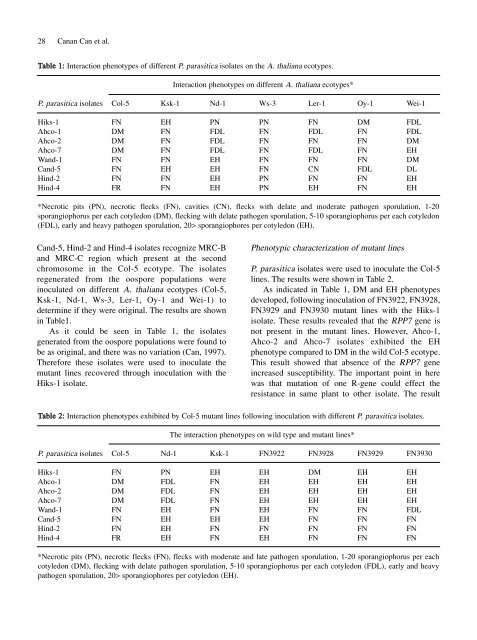(Converted)-4 - Journal of Cell and Molecular Biology - Haliç ...
(Converted)-4 - Journal of Cell and Molecular Biology - Haliç ...
(Converted)-4 - Journal of Cell and Molecular Biology - Haliç ...
You also want an ePaper? Increase the reach of your titles
YUMPU automatically turns print PDFs into web optimized ePapers that Google loves.
28 Canan Can et al.<br />
Table 1: Interaction phenotypes <strong>of</strong> different P. parasitica isolates on the A. thaliana ecotypes.<br />
C<strong>and</strong>-5, Hind-2 <strong>and</strong> Hind-4 isolates recognize MRC-B<br />
<strong>and</strong> MRC-C region which present at the second<br />
chromosome in the Col-5 ecotype. The isolates<br />
regenerated from the oospore populations were<br />
inoculated on different A. thaliana ecotypes (Col-5,<br />
Ksk-1, Nd-1, Ws-3, Ler-1, Oy-1 <strong>and</strong> Wei-1) to<br />
determine if they were original. The results are shown<br />
in Table1.<br />
As it could be seen in Table 1, the isolates<br />
generated from the oospore populations were found to<br />
be as original, <strong>and</strong> there was no variation (Can, 1997).<br />
Therefore these isolates were used to inoculate the<br />
mutant lines recovered through inoculation with the<br />
Hiks-1 isolate.<br />
Interaction phenotypes on different A. thaliana ecotypes*<br />
P. parasitica isolates Col-5 Ksk-1 Nd-1 Ws-3 Ler-1 Oy-1 Wei-1<br />
Hiks-1 FN EH PN PN FN DM FDL<br />
Ahco-1 DM FN FDL FN FDL FN FDL<br />
Ahco-2 DM FN FDL FN FN FN DM<br />
Ahco-7 DM FN FDL FN FDL FN EH<br />
W<strong>and</strong>-1 FN FN EH FN FN FN DM<br />
C<strong>and</strong>-5 FN EH EH FN CN FDL DL<br />
Hind-2 FN FN EH PN FN FN EH<br />
Hind-4 FR FN EH PN EH FN EH<br />
*Necrotic pits (PN), necrotic flecks (FN), cavities (CN), flecks with delate <strong>and</strong> moderate pathogen sporulation, 1-20<br />
sporangiophorus per each cotyledon (DM), flecking with delate pathogen sporulation, 5-10 sporangiophorus per each cotyledon<br />
(FDL), early <strong>and</strong> heavy pathogen sporulation, 20> sporangiophores per cotyledon (EH).<br />
Phenotypic characterization <strong>of</strong> mutant lines<br />
P. parasitica isolates were used to inoculate the Col-5<br />
lines. The results were shown in Table 2.<br />
As indicated in Table 1, DM <strong>and</strong> EH phenotypes<br />
developed, following inoculation <strong>of</strong> FN3922, FN3928,<br />
FN3929 <strong>and</strong> FN3930 mutant lines with the Hiks-1<br />
isolate. These results revealed that the RPP7 gene is<br />
not present in the mutant lines. However, Ahco-1,<br />
Ahco-2 <strong>and</strong> Ahco-7 isolates exhibited the EH<br />
phenotype compared to DM in the wild Col-5 ecotype.<br />
This result showed that absence <strong>of</strong> the RPP7 gene<br />
increased susceptibility. The important point in here<br />
was that mutation <strong>of</strong> one R-gene could effect the<br />
resistance in same plant to other isolate. The result<br />
Table 2: Interaction phenotypes exhibited by Col-5 mutant lines following inoculation with different P. parasitica isolates.<br />
The interaction phenotypes on wild type <strong>and</strong> mutant lines*<br />
P. parasitica isolates Col-5 Nd-1 Ksk-1 FN3922 FN3928 FN3929 FN3930<br />
Hiks-1 FN PN EH EH DM EH EH<br />
Ahco-1 DM FDL FN EH EH EH EH<br />
Ahco-2 DM FDL FN EH EH EH EH<br />
Ahco-7 DM FDL FN EH EH EH EH<br />
W<strong>and</strong>-1 FN EH FN EH FN FN FDL<br />
C<strong>and</strong>-5 FN EH EH EH FN FN FN<br />
Hind-2 FN EH FN FN FN FN FN<br />
Hind-4 FR EH FN EH FN FN FN<br />
*Necrotic pits (PN), necrotic flecks (FN), flecks with moderate <strong>and</strong> late pathogen sporulation, 1-20 sporangiophorus per each<br />
cotyledon (DM), flecking with delate pathogen sporulation, 5-10 sporangiophorus per each cotyledon (FDL), early <strong>and</strong> heavy<br />
pathogen sporulation, 20> sporangiophores per cotyledon (EH).
















